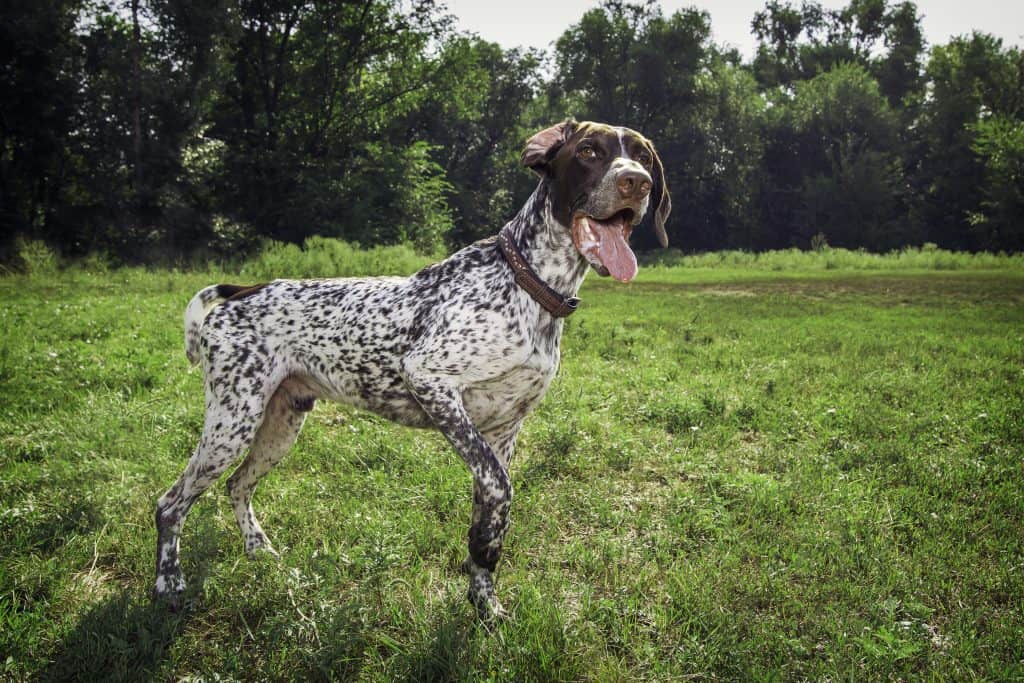Can Pointers Live in Apartments? A Complete Guide.
Getting a pointer for your apartment can be a big decision. Knowing what dog breed will do well in an apartment situation is difficult due to their varying characteristics and needs.
Pointers are not recommended for apartment living. They require too much attention and exercise to be cooped up. There are ways to make apartment living work with a pointer, but it requires constant attention and a lifestyle adjustment.
There are many dog breeds that do well in apartment living situations. Pointers are never included in that list because of their energy and needs. It would be hard to have them there for multiple reasons, but this does not mean that there aren’t ways to make it work.
Pointers in Apartments
Living in an apartment with a pointer has a lot of challenges. Pointers aren’t responsive to a passive lifestyle. They want to be outside running and chasing things. They are constantly fighting their deep desires to be with their family and desperate need to be active outdoors.
Apartment living with a pet is always difficult. In normal situations, you may have a doggy door or a dog that exclusively sleeps in the backyard. In both of these cases, you mainly have to feed them, play with them, and keep them safe and healthy.
In an apartment situation, you will need to do a lot more than that. You will have to take out your dog on a leash multiple times throughout the day to allow them to use the bathroom.
You will have to teach them not to bark at foot traffic outside the door or noises that they hear from other apartments. They will need to be taken out regularly for exercise to make sure that they are staying healthy.
These things all relate to having a pointer in an apartment too, but pointers will require even more work than other dogs more suited to apartment living would require.
Why Pointers Aren’t Recommended
The pointer is not recommended for apartment living because of the breed’s specific characteristics. Pointers are high energy and needy. They require a lot of attention and exercise.
Apartments are typically small and rarely have yards. A lot of the time people find themselves on the 2nd, 3rd, 4th+ floors! This isn’t ideal for dogs in general because it requires a lot more work and planning to take them out.
You can’t just open a door and let them run around a fenced-in yard, you have to leash them and accompany them multiple times a day to the bathroom.
Pointers need the stimulation of the outside world. They smell things, hear things, and see things that engage their minds and keep them happy. When they’re cooped up in a small space all day without the option of going outside, they can very often become destructive.
To compensate for their pent up energy and lack of mental stimulation, pointers are known to bark, chew, and whine. You and your neighbors will respond negatively to consistent bad behavior.
They need a lot of exercise and playtime to utilize their bodies and minds. Apartments, again, don’t have yards attached to them. Openly dog-friendly apartment complexes may have a dog park on site, but they are typically small and crowded.
It’s a good idea to socialize your pointer with other dogs, but you will need to take them out somewhere they can run around a large field or run next to you through the streets. Everything they require each day cannot be found in the confines of an apartment complex.
That’s a very important note for a hopeful apartment/pointer owners. You will need to dedicate time and energy to taking them out to do their business, take them away to allow them to burn off excess energy, and keep them occupied while they have to stay inside.

If all these things are met for them, the pointer can be a really great house pet. This is definitely an example of doing a lot of work to earn a reward. Nothing comes easy to a pointer owner in general, but living in an apartment with one will increase the workload.
Best Home Environments for Pointers
We want our experience owning a pointer to be a happy companionship filled with love, joy, and peace. We can easily cross the border into negativity and resentment if we too often contain our pointer without taking certain precautions.
Pointers respond best to living in a house with an active family that has a big fenced-in yard. Those are three very specific environments. A house always is going to have more room to roam than an apartment does.
Pointers respond best to living in a house with an active family that has a big fenced-in yard.
Houses also have the added benefit of giving the owner the option to put in a doggie door that allows your pointer to enter and exit whenever nature calls or they need to play!
An active family is ideal because playing fetch in the back yard is never going to be enough for these impressive athletes. They need to be taken on walks, runs, bike rides, etc to expel that excess energy. Vigorous exercise is part of the puzzle that leads to a happy and calm pointer.
Don’t get me wrong, fetch is also a very important game to play with your pointer. A lot of the time people don’t realize that running the energy out of your pointer is not enough. They are very intelligent creatures and require a lot of mental stimulation through games and activities.
This is another plus side to a big yard because you or the kids can go out there and throw the ball for hours.
Having a pointer in an apartment is not an impossible lifestyle. You will just have to train them not to bark when they hear noises outside the door from neighbors coming or going and whenever they smell another dog nearby.
You will also have to get them into a familiar routine of what they can do when you’re gone and what times of day they will be taken to the bathroom and allowed outside to play and exercise. Apartments have significantly more rules for pointers than houses do.
It’ll be vitally important to help your dog recognize the ins and outs of happy apartment living and allow them the peace of mind knowing when you’ll be back and what happens after that.
Another huge benefit to having a yard instead of just an apartment building is that your dog can engage in many natural mentally stimulating activities. They can sniff and chase birds and squirrels. They can roam around and explore.
This is something that has to be kept in mind when living in an apartment because taking them out just to run them hard is not going to suffice. You also need to play with them and get their minds moving. Then you will have the calm happy dog you’ve been hoping for.
The Benefits of a Puppy in an Apartment
Just because pointers aren’t recommended for apartment living doesn’t mean that it’s impossible to live happily with one. You will need to dedicate a lot more time and effort into training and daily exercise, but if you are dedicated to the task then you can have a happy dog and life.
If you hope to have a pointer as your apartment companion, there are ways to make it work.
Getting an older pointer from a shelter, for example, is going to be hard in an apartment because that dog may be used to having consistent access to a yard or may not do well with constant noise or activity so close to their territory.
On the other hand, you may hope to take a dog you already own from house living to apartment living. This won’t be an easy transition because pointers are creatures of habit. They will be used to a certain way of life and expect the same things from it.
If they are used to running around a backyard all day long, then they won’t react well to being stuck inside while you’re out at work. They can easily become bored and develop separation anxiety.
Transitioning an older dog is always going to be a lot harder than introducing a young one.
One almost sure-fire way to have success in owning an apartment dog is to train them inside of one from puppyhood.

A puppy has a moldable mind. Their behaviors haven’t become deep seeded habits yet. It’s like the saying “you can’t teach an old dog new tricks” goes, but instead of talking about an older human, we are talking about a literal canine.
This metaphor isn’t perfect because people and animals have the innate ability to learn throughout their lives. The point I’m trying to make is that it is significantly harder to break an old habit than it is to develop a new one.
Puppies will be able to be trained for your lifestyle which will help keep you semi-sane for years to come. One general rule of being a puppy is that you are small. You may have a big puppy, but a puppy will always be just a small dog.
Given building size restrictions, puppies are good for apartments because they are small. The other side of that equation is that puppies are small but have boundless energy, and when you have a pointer puppy then the energy levels skyrocket.
They are easily contained, though. They are eager to please and want to have fun. Puppies are a nightmare but also a joy. They won’t be puppies for long, but training one early can help guarantee you a better behaved dog in the future.
Training for an Apartment
Training a puppy for apartment living is going to require time and patience. They aren’t going to learn the rules overnight. It’s going to take a while but will be worth it in the end.
Consistency is absolutely key when training your puppy in an apartment. These creatures can be stubborn, but they are also very intelligent. They respond well to consistency and positive rewards when they accomplish something.
Consistency is key when training your puppy in an apartment.
It is going to be important when bringing a pointer puppy into an apartment to start training immediately. They won’t need vigorous exercise as much as active playtime when they’re very young, so take advantage of that time to start your training.
Indoor Training
One of the hardest things to accomplish in an apartment situation is house training your dog. A lot of the time they will only indicate their need to go when it’s too late to run down a few flights of stairs to a grass patch.
Apartment owners find puppy training pads to be helpful to catch last-minute emergencies. They are also useful when you leave your puppy at home throughout the day or during the night. Puppies have tiny bladders and will need to go a lot more often than older dogs.
The problem with the pads is that overusing them can make your puppy associate them with the only place to go to the bathroom. You will want their main go-to place to be outside in the grass.
The first step will be to locate around your apartment building where you will bring your puppy to go to the bathroom every day. You’ll always want to remember to bring something to clean up your dogs waste because they will be going to a public place.
Showing your dog where the bathroom is can be accomplished by consistently looking for signs of your puppy needing to go.
This can be them whining, sniffing around, and heading towards the corner of rooms. Pick them up and head outside as quickly as possible. Take them to a designated area and allow them to go.
There are going to be a few accidents, so don’t become discouraged when your puppy doesn’t pick it up immediately. It’s probably going to take a few weeks or months.
Crate Training
Indoor or house training goes hand in hand with crate training. A dog that is crate trained will usually respond better to house training.
The tie between the two happens when the dog is unwilling to pee in the place they’re going to sleep, so they will try to hold it until they get out. Immediately after taking them out of the crate, the owner should take them outside and reward them.
This can help your puppy become familiar with the idea that the business happens outside.
You want your puppy to be comfortable with and used to a crate no matter if you’re living in a house or apartment. Puppies need to be contained to keep from destroying the house with their zeal. It also helps to control their ability to roam around the house and pee where they want.
Being comfortable in the crate is the first step because your puppy isn’t going to be happy to be confined by themselves. You’ll want to be patient and help your puppy go into the crate by themselves.
A good thing to try for pointers is to teach them simple commands like “sit” and “come” first. Every time they correctly execute the command, give them a treat.
After they can do this consistently, you can try introducing them to the crate. Walk them towards the crate and allow them to sniff around and try a few things to get their reward.
Wait until they put their nose inside of the crate to praise them and give them a treat. Keep this exercise up, walking towards the crate and trying to get them to go inside. Don’t force them or get mad.
If it’s taking them a lot of time to figure out what you want, grab their collar and use gentle pressure to lead them into the crate. Once they go in, give them a treat. Continue the exercise until your puppy walks into the crate on its own. This may take a long time, but your puppy will soon understand.
You will want to continue this exercise by adding on a command such as “kennel” to associate the action with a command. Eventually, your puppy will recognize that this behavior will be rewarded with good things and go when commanded.
There are other ways to crate train your puppy, but this has been an effective way for pointers in the past.
Socialization and Barking
Socializing your pointer will go a long way in helping them become comfortable and familiar with the noise and bustle of foot traffic around apartment buildings.
You can take them to dog parks and on walks with people around. Your puppy may be a bit overwhelmed at first, so be gentle. It’s important for them to be around other people and dogs to gain that friendliness that’s characteristic to pointers.

Another exercise you can try with your pointer is rewarding them whenever they are aware of people walking around outside the door but don’t bark.
Positive reinforcement is key to conditioning your pointer for good behaviors.
Other things that are good practices for your pointer is designating a small part of the apartment as a “play zone”. This can be where your puppy’s toys are always put away.
Boundaries are important for pet apartment living. Train them to understand where they sleep, play, and use the restroom. After all the training becomes fruitful, you will be able to reap the benefits of a pointer in your apartment.
These are all things you could also do with an older pointer, but the training will be significantly more challenging and you never know how they’ll react to the change.
Schedules
One of the most effective ways to get your pointer acclimated to apartment living is by having a set schedule you both follow every day. This would include eating times, potty times, and exercise times.
If your puppy gets used to doing these things every day around the same time then they will better be able to control themselves until the times come around to relieve themselves or go outside to play.
This is the thing that many owners have found to be the most effective training tool. Pointers respond extremely well to consistency in their lives. They will be calmer throughout the day and at night if they are receiving the exercise, stimulation, food, and bathroom time they need and expect.
Everything I’ve been describing takes hard work and commitment. It’s not impossible, but it is going to be difficult. Pointers aren’t recommended for apartment living, so make sure to keep that in mind when deciding where to live with your pointer or what kind of dog to get when you have an apartment.
